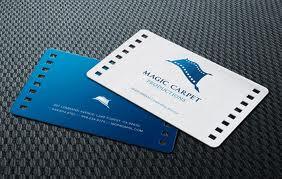
Even in a world filled with modern ways of contacting one another
(think Facebook, email and other online communication,) the business
card is still an essential part of networking practices. Whether used at
networking events or to give to someone met on happenstance, these
cards are meant to leave a lasting impression and represent a specific
business individual. Plain and simple cards may work well for other
profession’s business cards but for professionals in the technology
trade, a business card needs to be modern, technically savvy, and
represent the industry. IT and other computer based experts are known
for having the latest technology devices and strategies, making it
difficult to create specialized cards on such a time honored, almost
anti-technology tradition. So, how do technically savvy professional
represent themselves through business cards? By following these seven
simple tips:
1. Use a Professional
Professional graphic designers have the ability to see your business
card vision and turn it into a reality. If you are serious about
standing out from the crowd, hiring a professional who knows the ins and
outs of business card design is the way to go. However, if it is not in
the budget, or you’d prefer to work with a template, there are business
card service websites which offer premium business cards for
professionals in all industries.
2. Choose a Modern Design
The field of technology is all about the modern technologies that
impact our daily lives. Sleek appliances, thin computers and mobile
devices are only a few of the modern designs currently trending in the
industries of technology. This translates to looking for a business card
with sleek designs and colors that fit your industry. The ultimate goal
is to have unique card that when someone looks at, they immediately
think of your profession.
3. Be Unique
A business card needs to stand out and be unique as the person whose
name is on it. By selecting from a variety of design options, colors and
personal information, technology professionals can create custom
business cards that represent them, their profession and their chosen
industry. Some business cards have unique features such as foils, hard
materials, and one-of-a-kind cuts which can help them stand out.
4. Include Color
Standard black and white cards tend to get lost or thrown away, but a
nice, eye catching and colorful card is one that many people will keep
and refer back to in the future. Color choices should be complementary
to company logo design or business color scheme while standing out and
remaining cohesive with other promotional paper materials.
5. Include a Professional Photo
A popular trend in business card design is to include a professional
headshot photo. This trend has been brought on by the current social
media technologies of Facebook and LinkedIn, where a majority of
professionals are now recognized through photos. Having a card with a
professionally taken head shot will not only make the card memorable but
will also help with recognition in later meetings.
6. Technological Contact Information
Many traditional business cards just list standard information such
as the name of a professional, their job title, their phone number and
possibly a web address. The business cards of today need to implement
all the avenues that are available for contact. This means incorporating
technological contact information such as a Facebook page URL, a
Twitter account, a website, an email address and a phone number. This
information is vital and must be included on most modern business cards,
especially those of technology professionals.
7. Implement Current Business Card Technology
The modern business card is more than just paper. New technologies
allow for things like QR codes, or scan-able computer chips to be a part
of the card while providing valuable information. QR codes can be
scanned by a phone’s camera and direct the card holder to a website or
Facebook page. The code can be changed daily to redirect the scanners to
current blog posts, twitter feeds or website pages. Implementing these
current card elements can speak volumes for professional in the
technology industry and truly sets them apart at business events such as
networking conferences or even more personal places like coffee shops.


